Report on Developing Successful Business Teams: Strategies and Models
VerifiedAdded on 2023/01/12
|16
|7293
|96
Report
AI Summary
This report examines the multifaceted aspects of developing successful business teams, covering key areas such as characteristics, roles, and development stages. It begins by identifying the core characteristics of high-performing teams, including effective communication, goal-oriented operations, equal contribution from members, collaboration, diversity, effective leadership, and well-organized tasks. The report then delves into the importance of team roles, using Belbin's theory to illustrate various roles like shaper, implementer, coordinator, and specialist. Furthermore, the report explores the stages of team development, strategies for motivating team members, methods for fostering open communication, and approaches to resolving team conflicts. Finally, it addresses performance monitoring against objectives and provides recommendations for improving team performance. The analysis incorporates real-world examples, such as the practices of Apple Inc., to illustrate concepts and provide practical insights for building and managing effective business teams.
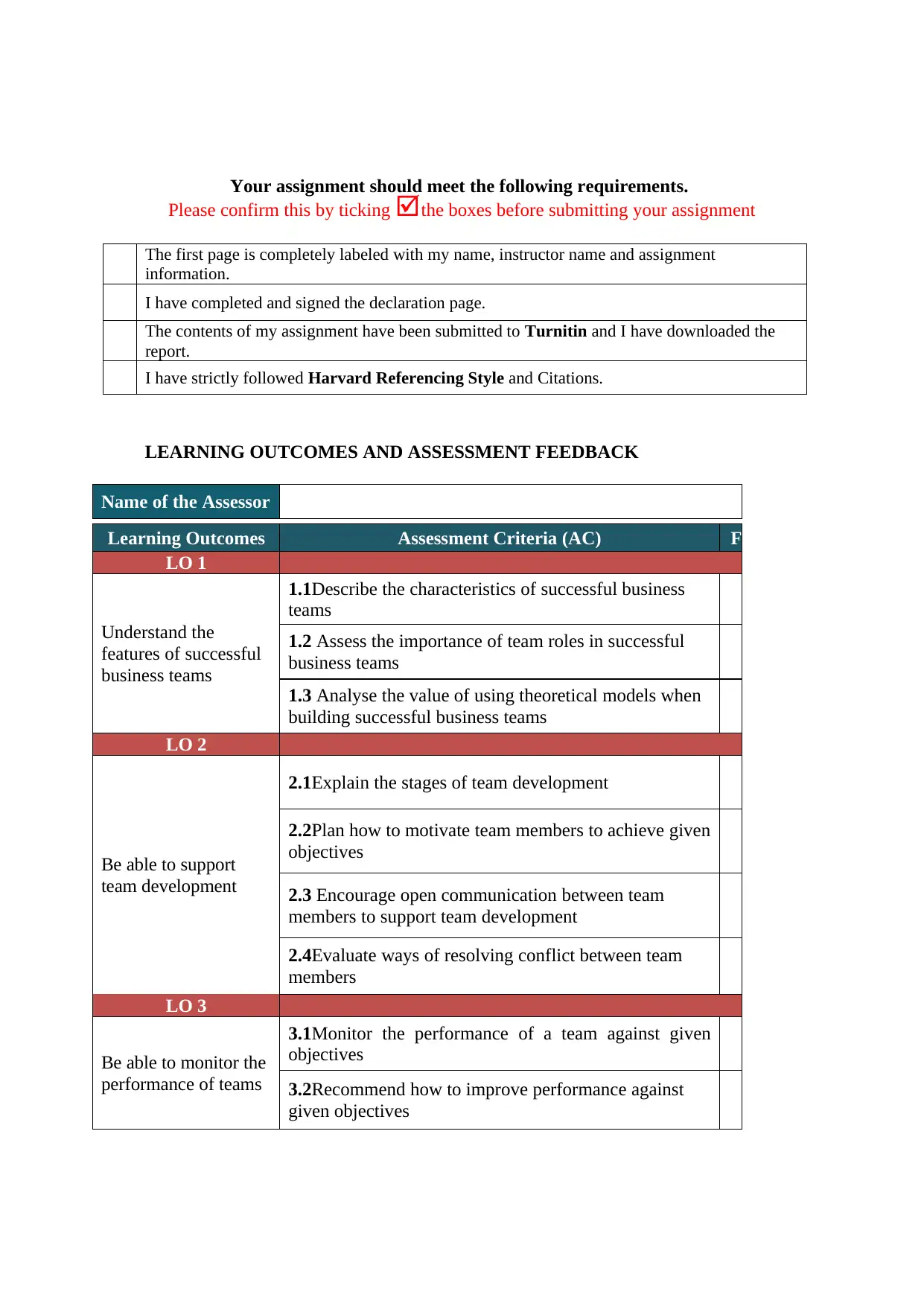
Your assignment should meet the following requirements.
Please confirm this by ticking the boxes before submitting your assignment
The first page is completely labeled with my name, instructor name and assignment
information.
I have completed and signed the declaration page.
The contents of my assignment have been submitted to Turnitin and I have downloaded the
report.
I have strictly followed Harvard Referencing Style and Citations.
LEARNING OUTCOMES AND ASSESSMENT FEEDBACK
Name of the Assessor
Learning Outcomes Assessment Criteria (AC) Feedback
LO 1
Understand the
features of successful
business teams
1.1Describe the characteristics of successful business
teams
1.2 Assess the importance of team roles in successful
business teams
1.3 Analyse the value of using theoretical models when
building successful business teams
LO 2
Be able to support
team development
2.1Explain the stages of team development
2.2Plan how to motivate team members to achieve given
objectives
2.3 Encourage open communication between team
members to support team development
2.4Evaluate ways of resolving conflict between team
members
LO 3
Be able to monitor the
performance of teams
3.1Monitor the performance of a team against given
objectives
3.2Recommend how to improve performance against
given objectives
Please confirm this by ticking the boxes before submitting your assignment
The first page is completely labeled with my name, instructor name and assignment
information.
I have completed and signed the declaration page.
The contents of my assignment have been submitted to Turnitin and I have downloaded the
report.
I have strictly followed Harvard Referencing Style and Citations.
LEARNING OUTCOMES AND ASSESSMENT FEEDBACK
Name of the Assessor
Learning Outcomes Assessment Criteria (AC) Feedback
LO 1
Understand the
features of successful
business teams
1.1Describe the characteristics of successful business
teams
1.2 Assess the importance of team roles in successful
business teams
1.3 Analyse the value of using theoretical models when
building successful business teams
LO 2
Be able to support
team development
2.1Explain the stages of team development
2.2Plan how to motivate team members to achieve given
objectives
2.3 Encourage open communication between team
members to support team development
2.4Evaluate ways of resolving conflict between team
members
LO 3
Be able to monitor the
performance of teams
3.1Monitor the performance of a team against given
objectives
3.2Recommend how to improve performance against
given objectives
Paraphrase This Document
Need a fresh take? Get an instant paraphrase of this document with our AI Paraphraser
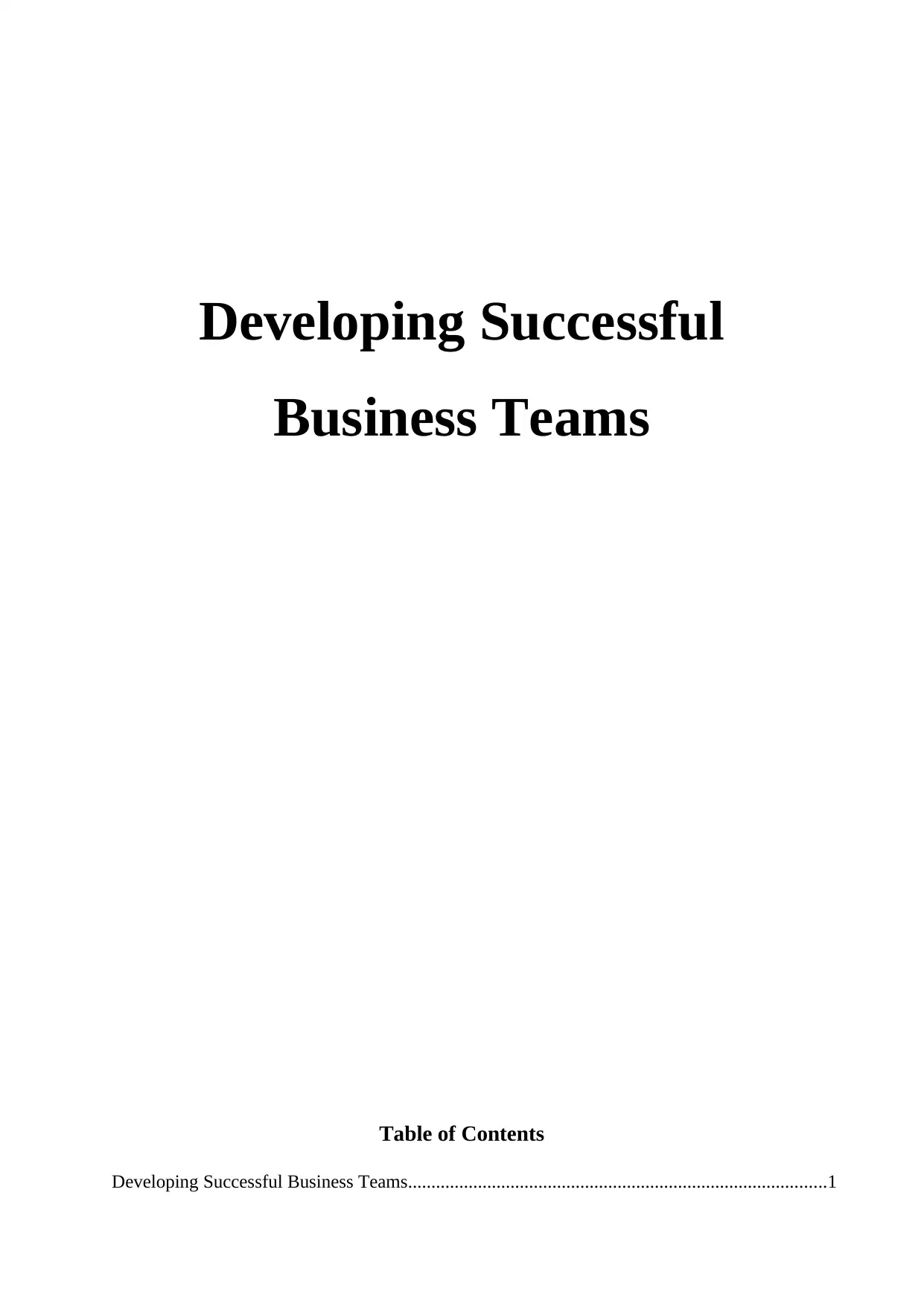
Developing Successful
Business Teams
Table of Contents
Developing Successful Business Teams..........................................................................................1
Business Teams
Table of Contents
Developing Successful Business Teams..........................................................................................1
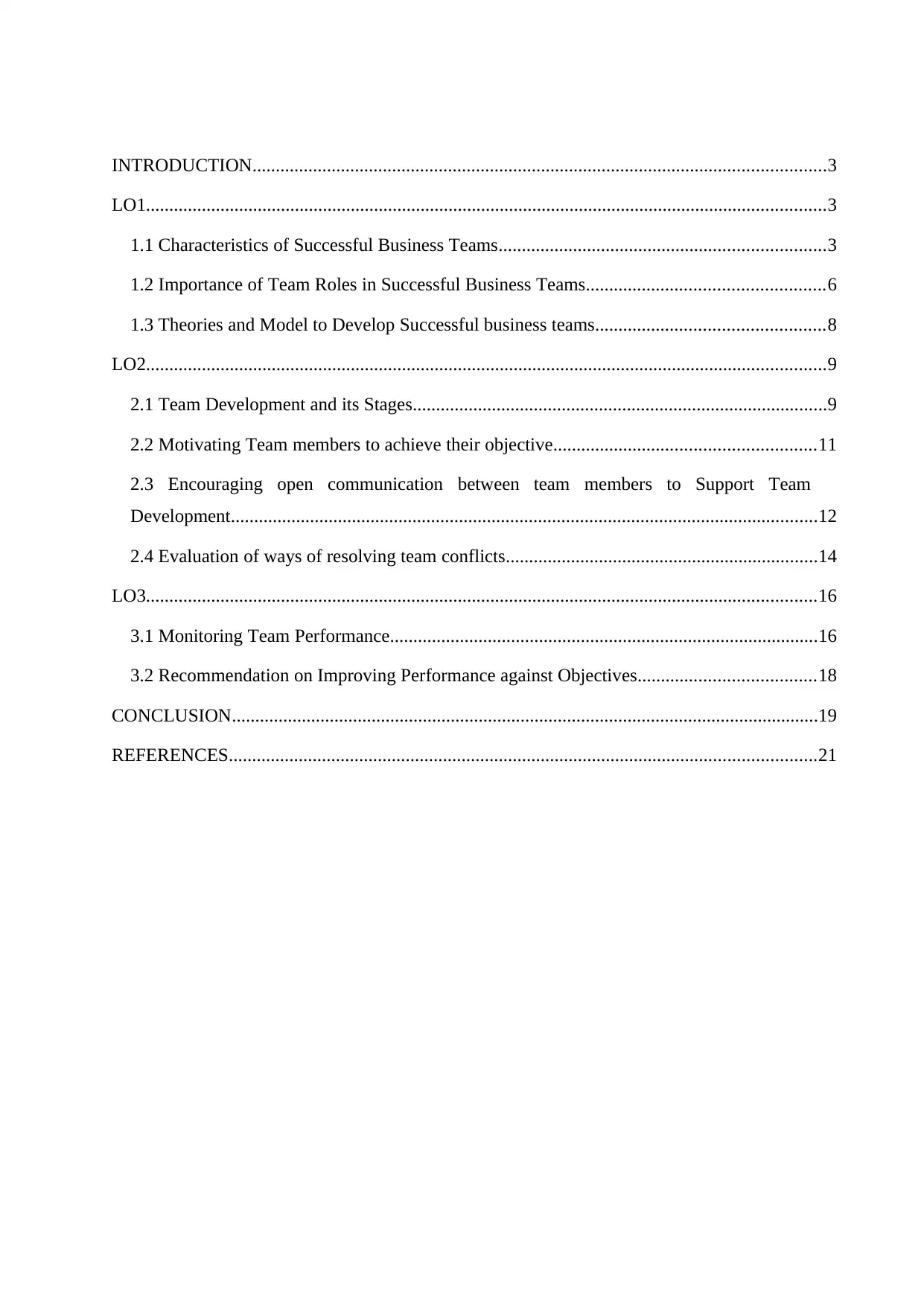
INTRODUCTION...........................................................................................................................3
LO1..................................................................................................................................................3
1.1 Characteristics of Successful Business Teams......................................................................3
1.2 Importance of Team Roles in Successful Business Teams...................................................6
1.3 Theories and Model to Develop Successful business teams.................................................8
LO2..................................................................................................................................................9
2.1 Team Development and its Stages.........................................................................................9
2.2 Motivating Team members to achieve their objective........................................................11
2.3 Encouraging open communication between team members to Support Team
Development..............................................................................................................................12
2.4 Evaluation of ways of resolving team conflicts...................................................................14
LO3................................................................................................................................................16
3.1 Monitoring Team Performance............................................................................................16
3.2 Recommendation on Improving Performance against Objectives......................................18
CONCLUSION..............................................................................................................................19
REFERENCES..............................................................................................................................21
LO1..................................................................................................................................................3
1.1 Characteristics of Successful Business Teams......................................................................3
1.2 Importance of Team Roles in Successful Business Teams...................................................6
1.3 Theories and Model to Develop Successful business teams.................................................8
LO2..................................................................................................................................................9
2.1 Team Development and its Stages.........................................................................................9
2.2 Motivating Team members to achieve their objective........................................................11
2.3 Encouraging open communication between team members to Support Team
Development..............................................................................................................................12
2.4 Evaluation of ways of resolving team conflicts...................................................................14
LO3................................................................................................................................................16
3.1 Monitoring Team Performance............................................................................................16
3.2 Recommendation on Improving Performance against Objectives......................................18
CONCLUSION..............................................................................................................................19
REFERENCES..............................................................................................................................21
⊘ This is a preview!⊘
Do you want full access?
Subscribe today to unlock all pages.

Trusted by 1+ million students worldwide
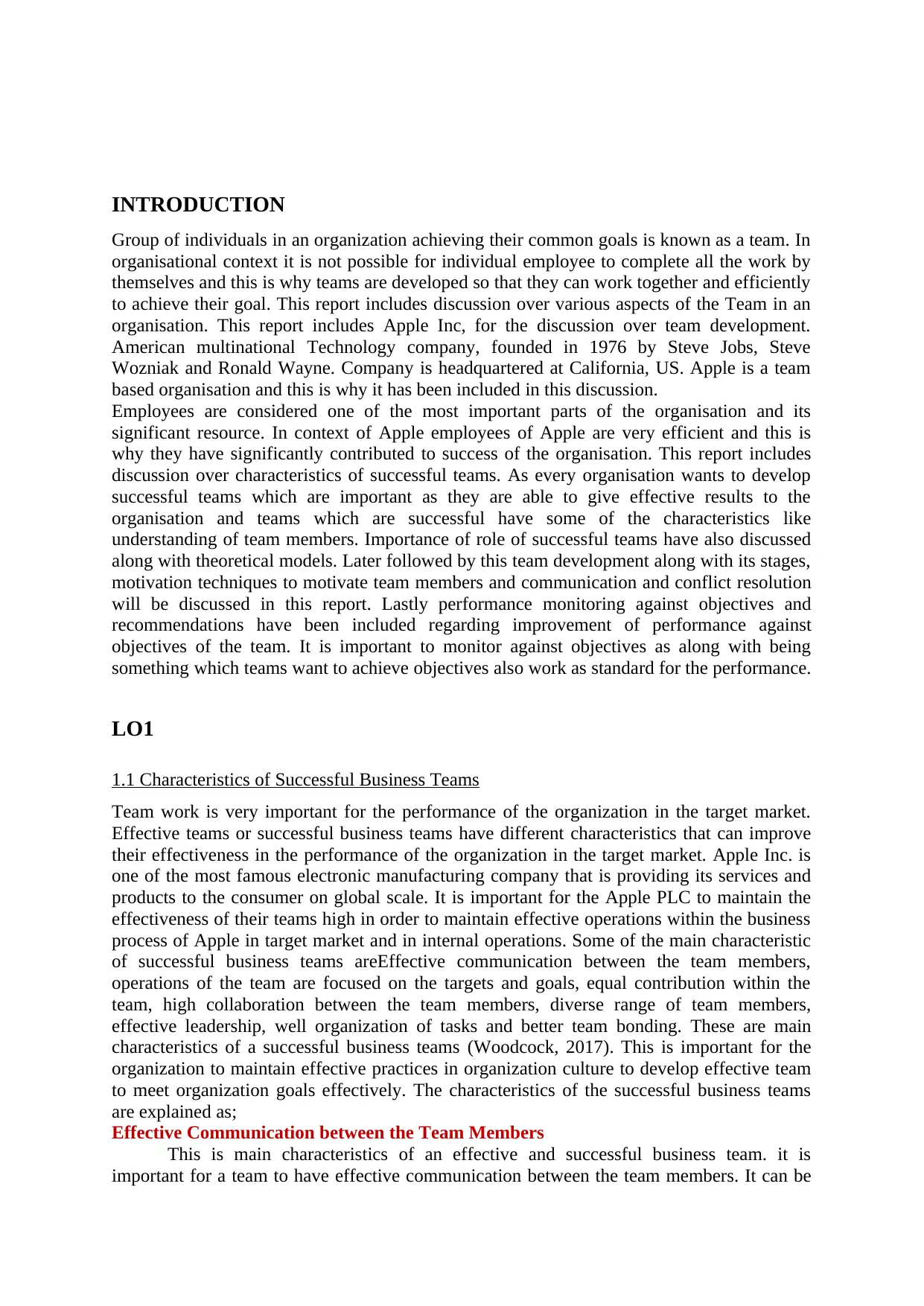
INTRODUCTION
Group of individuals in an organization achieving their common goals is known as a team. In
organisational context it is not possible for individual employee to complete all the work by
themselves and this is why teams are developed so that they can work together and efficiently
to achieve their goal. This report includes discussion over various aspects of the Team in an
organisation. This report includes Apple Inc, for the discussion over team development.
American multinational Technology company, founded in 1976 by Steve Jobs, Steve
Wozniak and Ronald Wayne. Company is headquartered at California, US. Apple is a team
based organisation and this is why it has been included in this discussion.
Employees are considered one of the most important parts of the organisation and its
significant resource. In context of Apple employees of Apple are very efficient and this is
why they have significantly contributed to success of the organisation. This report includes
discussion over characteristics of successful teams. As every organisation wants to develop
successful teams which are important as they are able to give effective results to the
organisation and teams which are successful have some of the characteristics like
understanding of team members. Importance of role of successful teams have also discussed
along with theoretical models. Later followed by this team development along with its stages,
motivation techniques to motivate team members and communication and conflict resolution
will be discussed in this report. Lastly performance monitoring against objectives and
recommendations have been included regarding improvement of performance against
objectives of the team. It is important to monitor against objectives as along with being
something which teams want to achieve objectives also work as standard for the performance.
LO1
1.1 Characteristics of Successful Business Teams
Team work is very important for the performance of the organization in the target market.
Effective teams or successful business teams have different characteristics that can improve
their effectiveness in the performance of the organization in the target market. Apple Inc. is
one of the most famous electronic manufacturing company that is providing its services and
products to the consumer on global scale. It is important for the Apple PLC to maintain the
effectiveness of their teams high in order to maintain effective operations within the business
process of Apple in target market and in internal operations. Some of the main characteristic
of successful business teams areEffective communication between the team members,
operations of the team are focused on the targets and goals, equal contribution within the
team, high collaboration between the team members, diverse range of team members,
effective leadership, well organization of tasks and better team bonding. These are main
characteristics of a successful business teams (Woodcock, 2017). This is important for the
organization to maintain effective practices in organization culture to develop effective team
to meet organization goals effectively. The characteristics of the successful business teams
are explained as;
Effective Communication between the Team Members
This is main characteristics of an effective and successful business team. it is
important for a team to have effective communication between the team members. It can be
Group of individuals in an organization achieving their common goals is known as a team. In
organisational context it is not possible for individual employee to complete all the work by
themselves and this is why teams are developed so that they can work together and efficiently
to achieve their goal. This report includes discussion over various aspects of the Team in an
organisation. This report includes Apple Inc, for the discussion over team development.
American multinational Technology company, founded in 1976 by Steve Jobs, Steve
Wozniak and Ronald Wayne. Company is headquartered at California, US. Apple is a team
based organisation and this is why it has been included in this discussion.
Employees are considered one of the most important parts of the organisation and its
significant resource. In context of Apple employees of Apple are very efficient and this is
why they have significantly contributed to success of the organisation. This report includes
discussion over characteristics of successful teams. As every organisation wants to develop
successful teams which are important as they are able to give effective results to the
organisation and teams which are successful have some of the characteristics like
understanding of team members. Importance of role of successful teams have also discussed
along with theoretical models. Later followed by this team development along with its stages,
motivation techniques to motivate team members and communication and conflict resolution
will be discussed in this report. Lastly performance monitoring against objectives and
recommendations have been included regarding improvement of performance against
objectives of the team. It is important to monitor against objectives as along with being
something which teams want to achieve objectives also work as standard for the performance.
LO1
1.1 Characteristics of Successful Business Teams
Team work is very important for the performance of the organization in the target market.
Effective teams or successful business teams have different characteristics that can improve
their effectiveness in the performance of the organization in the target market. Apple Inc. is
one of the most famous electronic manufacturing company that is providing its services and
products to the consumer on global scale. It is important for the Apple PLC to maintain the
effectiveness of their teams high in order to maintain effective operations within the business
process of Apple in target market and in internal operations. Some of the main characteristic
of successful business teams areEffective communication between the team members,
operations of the team are focused on the targets and goals, equal contribution within the
team, high collaboration between the team members, diverse range of team members,
effective leadership, well organization of tasks and better team bonding. These are main
characteristics of a successful business teams (Woodcock, 2017). This is important for the
organization to maintain effective practices in organization culture to develop effective team
to meet organization goals effectively. The characteristics of the successful business teams
are explained as;
Effective Communication between the Team Members
This is main characteristics of an effective and successful business team. it is
important for a team to have effective communication between the team members. It can be
Paraphrase This Document
Need a fresh take? Get an instant paraphrase of this document with our AI Paraphraser
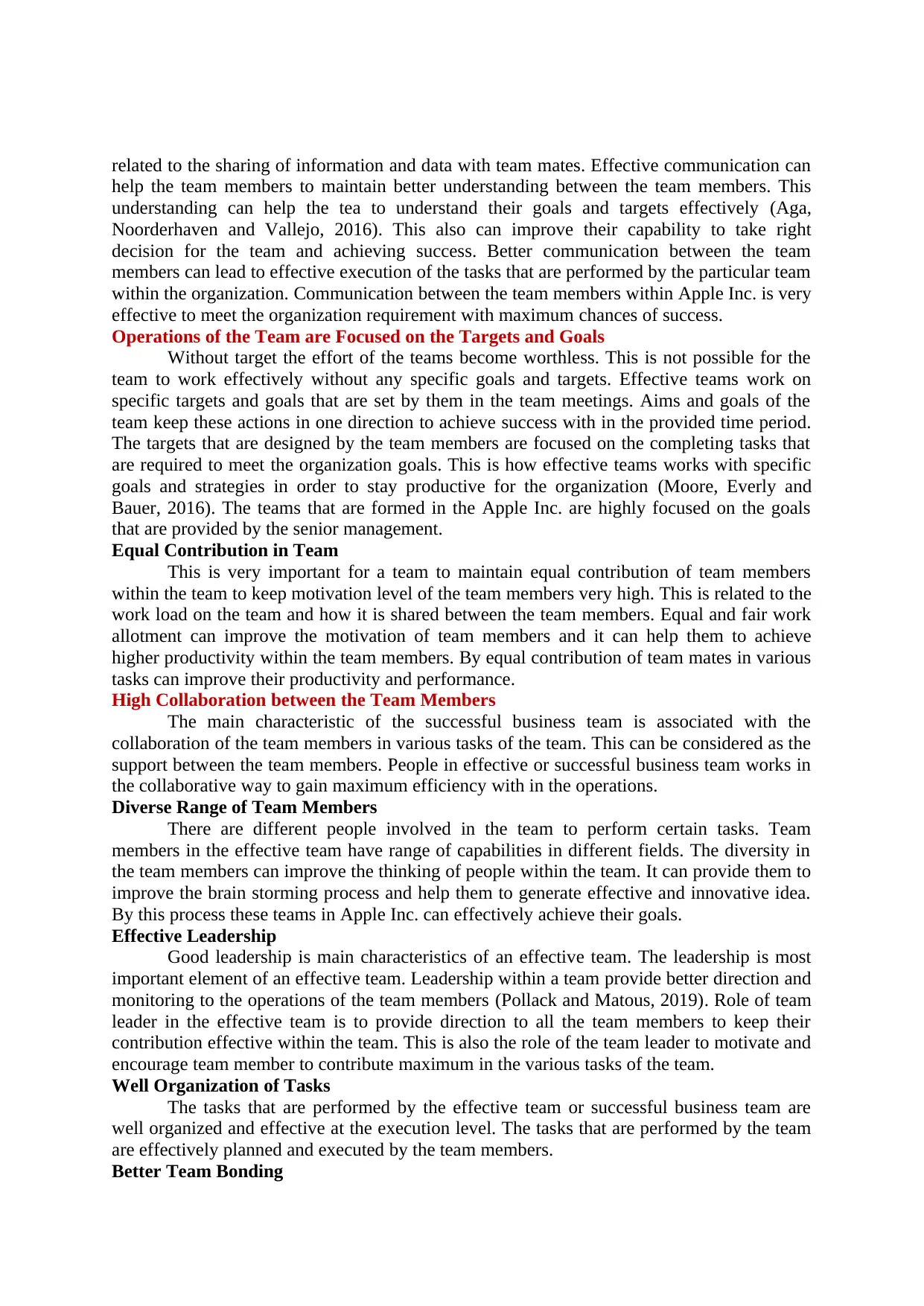
related to the sharing of information and data with team mates. Effective communication can
help the team members to maintain better understanding between the team members. This
understanding can help the tea to understand their goals and targets effectively (Aga,
Noorderhaven and Vallejo, 2016). This also can improve their capability to take right
decision for the team and achieving success. Better communication between the team
members can lead to effective execution of the tasks that are performed by the particular team
within the organization. Communication between the team members within Apple Inc. is very
effective to meet the organization requirement with maximum chances of success.
Operations of the Team are Focused on the Targets and Goals
Without target the effort of the teams become worthless. This is not possible for the
team to work effectively without any specific goals and targets. Effective teams work on
specific targets and goals that are set by them in the team meetings. Aims and goals of the
team keep these actions in one direction to achieve success with in the provided time period.
The targets that are designed by the team members are focused on the completing tasks that
are required to meet the organization goals. This is how effective teams works with specific
goals and strategies in order to stay productive for the organization (Moore, Everly and
Bauer, 2016). The teams that are formed in the Apple Inc. are highly focused on the goals
that are provided by the senior management.
Equal Contribution in Team
This is very important for a team to maintain equal contribution of team members
within the team to keep motivation level of the team members very high. This is related to the
work load on the team and how it is shared between the team members. Equal and fair work
allotment can improve the motivation of team members and it can help them to achieve
higher productivity within the team members. By equal contribution of team mates in various
tasks can improve their productivity and performance.
High Collaboration between the Team Members
The main characteristic of the successful business team is associated with the
collaboration of the team members in various tasks of the team. This can be considered as the
support between the team members. People in effective or successful business team works in
the collaborative way to gain maximum efficiency with in the operations.
Diverse Range of Team Members
There are different people involved in the team to perform certain tasks. Team
members in the effective team have range of capabilities in different fields. The diversity in
the team members can improve the thinking of people within the team. It can provide them to
improve the brain storming process and help them to generate effective and innovative idea.
By this process these teams in Apple Inc. can effectively achieve their goals.
Effective Leadership
Good leadership is main characteristics of an effective team. The leadership is most
important element of an effective team. Leadership within a team provide better direction and
monitoring to the operations of the team members (Pollack and Matous, 2019). Role of team
leader in the effective team is to provide direction to all the team members to keep their
contribution effective within the team. This is also the role of the team leader to motivate and
encourage team member to contribute maximum in the various tasks of the team.
Well Organization of Tasks
The tasks that are performed by the effective team or successful business team are
well organized and effective at the execution level. The tasks that are performed by the team
are effectively planned and executed by the team members.
Better Team Bonding
help the team members to maintain better understanding between the team members. This
understanding can help the tea to understand their goals and targets effectively (Aga,
Noorderhaven and Vallejo, 2016). This also can improve their capability to take right
decision for the team and achieving success. Better communication between the team
members can lead to effective execution of the tasks that are performed by the particular team
within the organization. Communication between the team members within Apple Inc. is very
effective to meet the organization requirement with maximum chances of success.
Operations of the Team are Focused on the Targets and Goals
Without target the effort of the teams become worthless. This is not possible for the
team to work effectively without any specific goals and targets. Effective teams work on
specific targets and goals that are set by them in the team meetings. Aims and goals of the
team keep these actions in one direction to achieve success with in the provided time period.
The targets that are designed by the team members are focused on the completing tasks that
are required to meet the organization goals. This is how effective teams works with specific
goals and strategies in order to stay productive for the organization (Moore, Everly and
Bauer, 2016). The teams that are formed in the Apple Inc. are highly focused on the goals
that are provided by the senior management.
Equal Contribution in Team
This is very important for a team to maintain equal contribution of team members
within the team to keep motivation level of the team members very high. This is related to the
work load on the team and how it is shared between the team members. Equal and fair work
allotment can improve the motivation of team members and it can help them to achieve
higher productivity within the team members. By equal contribution of team mates in various
tasks can improve their productivity and performance.
High Collaboration between the Team Members
The main characteristic of the successful business team is associated with the
collaboration of the team members in various tasks of the team. This can be considered as the
support between the team members. People in effective or successful business team works in
the collaborative way to gain maximum efficiency with in the operations.
Diverse Range of Team Members
There are different people involved in the team to perform certain tasks. Team
members in the effective team have range of capabilities in different fields. The diversity in
the team members can improve the thinking of people within the team. It can provide them to
improve the brain storming process and help them to generate effective and innovative idea.
By this process these teams in Apple Inc. can effectively achieve their goals.
Effective Leadership
Good leadership is main characteristics of an effective team. The leadership is most
important element of an effective team. Leadership within a team provide better direction and
monitoring to the operations of the team members (Pollack and Matous, 2019). Role of team
leader in the effective team is to provide direction to all the team members to keep their
contribution effective within the team. This is also the role of the team leader to motivate and
encourage team member to contribute maximum in the various tasks of the team.
Well Organization of Tasks
The tasks that are performed by the effective team or successful business team are
well organized and effective at the execution level. The tasks that are performed by the team
are effectively planned and executed by the team members.
Better Team Bonding
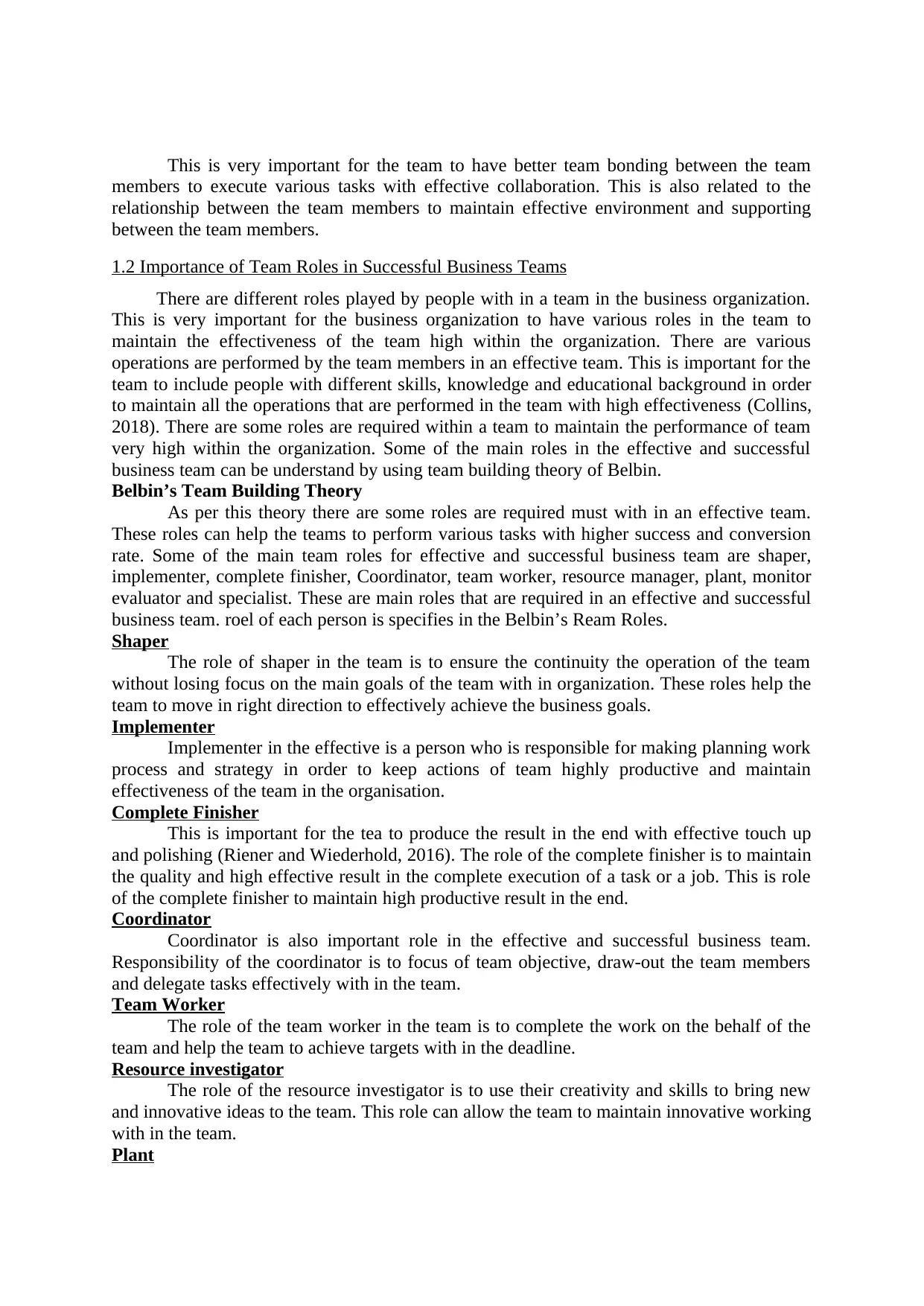
This is very important for the team to have better team bonding between the team
members to execute various tasks with effective collaboration. This is also related to the
relationship between the team members to maintain effective environment and supporting
between the team members.
1.2 Importance of Team Roles in Successful Business Teams
There are different roles played by people with in a team in the business organization.
This is very important for the business organization to have various roles in the team to
maintain the effectiveness of the team high within the organization. There are various
operations are performed by the team members in an effective team. This is important for the
team to include people with different skills, knowledge and educational background in order
to maintain all the operations that are performed in the team with high effectiveness (Collins,
2018). There are some roles are required within a team to maintain the performance of team
very high within the organization. Some of the main roles in the effective and successful
business team can be understand by using team building theory of Belbin.
Belbin’s Team Building Theory
As per this theory there are some roles are required must with in an effective team.
These roles can help the teams to perform various tasks with higher success and conversion
rate. Some of the main team roles for effective and successful business team are shaper,
implementer, complete finisher, Coordinator, team worker, resource manager, plant, monitor
evaluator and specialist. These are main roles that are required in an effective and successful
business team. roel of each person is specifies in the Belbin’s Ream Roles.
Shaper
The role of shaper in the team is to ensure the continuity the operation of the team
without losing focus on the main goals of the team with in organization. These roles help the
team to move in right direction to effectively achieve the business goals.
Implementer
Implementer in the effective is a person who is responsible for making planning work
process and strategy in order to keep actions of team highly productive and maintain
effectiveness of the team in the organisation.
Complete Finisher
This is important for the tea to produce the result in the end with effective touch up
and polishing (Riener and Wiederhold, 2016). The role of the complete finisher is to maintain
the quality and high effective result in the complete execution of a task or a job. This is role
of the complete finisher to maintain high productive result in the end.
Coordinator
Coordinator is also important role in the effective and successful business team.
Responsibility of the coordinator is to focus of team objective, draw-out the team members
and delegate tasks effectively with in the team.
Team Worker
The role of the team worker in the team is to complete the work on the behalf of the
team and help the team to achieve targets with in the deadline.
Resource investigator
The role of the resource investigator is to use their creativity and skills to bring new
and innovative ideas to the team. This role can allow the team to maintain innovative working
with in the team.
Plant
members to execute various tasks with effective collaboration. This is also related to the
relationship between the team members to maintain effective environment and supporting
between the team members.
1.2 Importance of Team Roles in Successful Business Teams
There are different roles played by people with in a team in the business organization.
This is very important for the business organization to have various roles in the team to
maintain the effectiveness of the team high within the organization. There are various
operations are performed by the team members in an effective team. This is important for the
team to include people with different skills, knowledge and educational background in order
to maintain all the operations that are performed in the team with high effectiveness (Collins,
2018). There are some roles are required within a team to maintain the performance of team
very high within the organization. Some of the main roles in the effective and successful
business team can be understand by using team building theory of Belbin.
Belbin’s Team Building Theory
As per this theory there are some roles are required must with in an effective team.
These roles can help the teams to perform various tasks with higher success and conversion
rate. Some of the main team roles for effective and successful business team are shaper,
implementer, complete finisher, Coordinator, team worker, resource manager, plant, monitor
evaluator and specialist. These are main roles that are required in an effective and successful
business team. roel of each person is specifies in the Belbin’s Ream Roles.
Shaper
The role of shaper in the team is to ensure the continuity the operation of the team
without losing focus on the main goals of the team with in organization. These roles help the
team to move in right direction to effectively achieve the business goals.
Implementer
Implementer in the effective is a person who is responsible for making planning work
process and strategy in order to keep actions of team highly productive and maintain
effectiveness of the team in the organisation.
Complete Finisher
This is important for the tea to produce the result in the end with effective touch up
and polishing (Riener and Wiederhold, 2016). The role of the complete finisher is to maintain
the quality and high effective result in the complete execution of a task or a job. This is role
of the complete finisher to maintain high productive result in the end.
Coordinator
Coordinator is also important role in the effective and successful business team.
Responsibility of the coordinator is to focus of team objective, draw-out the team members
and delegate tasks effectively with in the team.
Team Worker
The role of the team worker in the team is to complete the work on the behalf of the
team and help the team to achieve targets with in the deadline.
Resource investigator
The role of the resource investigator is to use their creativity and skills to bring new
and innovative ideas to the team. This role can allow the team to maintain innovative working
with in the team.
Plant
⊘ This is a preview!⊘
Do you want full access?
Subscribe today to unlock all pages.

Trusted by 1+ million students worldwide
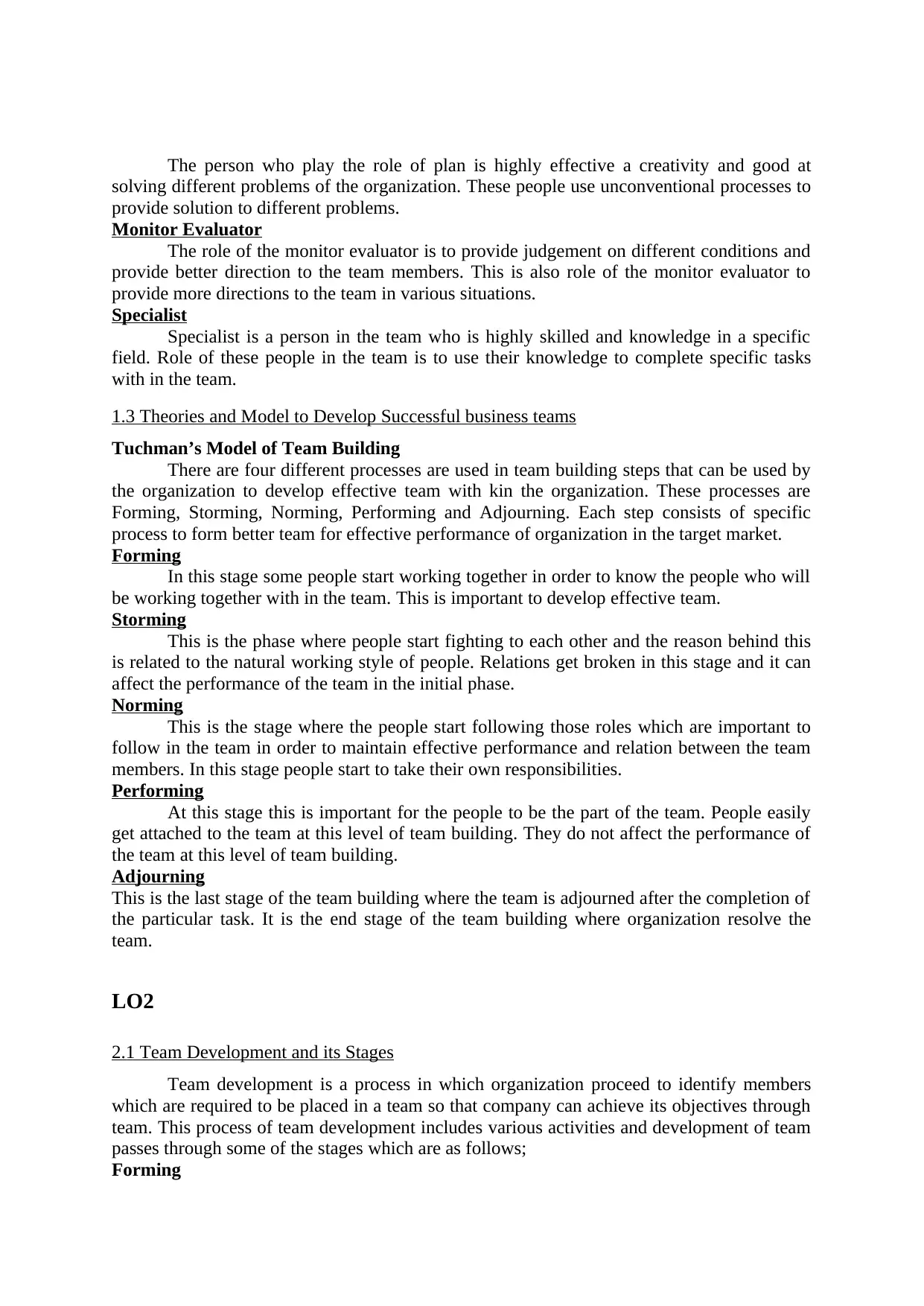
The person who play the role of plan is highly effective a creativity and good at
solving different problems of the organization. These people use unconventional processes to
provide solution to different problems.
Monitor Evaluator
The role of the monitor evaluator is to provide judgement on different conditions and
provide better direction to the team members. This is also role of the monitor evaluator to
provide more directions to the team in various situations.
Specialist
Specialist is a person in the team who is highly skilled and knowledge in a specific
field. Role of these people in the team is to use their knowledge to complete specific tasks
with in the team.
1.3 Theories and Model to Develop Successful business teams
Tuchman’s Model of Team Building
There are four different processes are used in team building steps that can be used by
the organization to develop effective team with kin the organization. These processes are
Forming, Storming, Norming, Performing and Adjourning. Each step consists of specific
process to form better team for effective performance of organization in the target market.
Forming
In this stage some people start working together in order to know the people who will
be working together with in the team. This is important to develop effective team.
Storming
This is the phase where people start fighting to each other and the reason behind this
is related to the natural working style of people. Relations get broken in this stage and it can
affect the performance of the team in the initial phase.
Norming
This is the stage where the people start following those roles which are important to
follow in the team in order to maintain effective performance and relation between the team
members. In this stage people start to take their own responsibilities.
Performing
At this stage this is important for the people to be the part of the team. People easily
get attached to the team at this level of team building. They do not affect the performance of
the team at this level of team building.
Adjourning
This is the last stage of the team building where the team is adjourned after the completion of
the particular task. It is the end stage of the team building where organization resolve the
team.
LO2
2.1 Team Development and its Stages
Team development is a process in which organization proceed to identify members
which are required to be placed in a team so that company can achieve its objectives through
team. This process of team development includes various activities and development of team
passes through some of the stages which are as follows;
Forming
solving different problems of the organization. These people use unconventional processes to
provide solution to different problems.
Monitor Evaluator
The role of the monitor evaluator is to provide judgement on different conditions and
provide better direction to the team members. This is also role of the monitor evaluator to
provide more directions to the team in various situations.
Specialist
Specialist is a person in the team who is highly skilled and knowledge in a specific
field. Role of these people in the team is to use their knowledge to complete specific tasks
with in the team.
1.3 Theories and Model to Develop Successful business teams
Tuchman’s Model of Team Building
There are four different processes are used in team building steps that can be used by
the organization to develop effective team with kin the organization. These processes are
Forming, Storming, Norming, Performing and Adjourning. Each step consists of specific
process to form better team for effective performance of organization in the target market.
Forming
In this stage some people start working together in order to know the people who will
be working together with in the team. This is important to develop effective team.
Storming
This is the phase where people start fighting to each other and the reason behind this
is related to the natural working style of people. Relations get broken in this stage and it can
affect the performance of the team in the initial phase.
Norming
This is the stage where the people start following those roles which are important to
follow in the team in order to maintain effective performance and relation between the team
members. In this stage people start to take their own responsibilities.
Performing
At this stage this is important for the people to be the part of the team. People easily
get attached to the team at this level of team building. They do not affect the performance of
the team at this level of team building.
Adjourning
This is the last stage of the team building where the team is adjourned after the completion of
the particular task. It is the end stage of the team building where organization resolve the
team.
LO2
2.1 Team Development and its Stages
Team development is a process in which organization proceed to identify members
which are required to be placed in a team so that company can achieve its objectives through
team. This process of team development includes various activities and development of team
passes through some of the stages which are as follows;
Forming
Paraphrase This Document
Need a fresh take? Get an instant paraphrase of this document with our AI Paraphraser
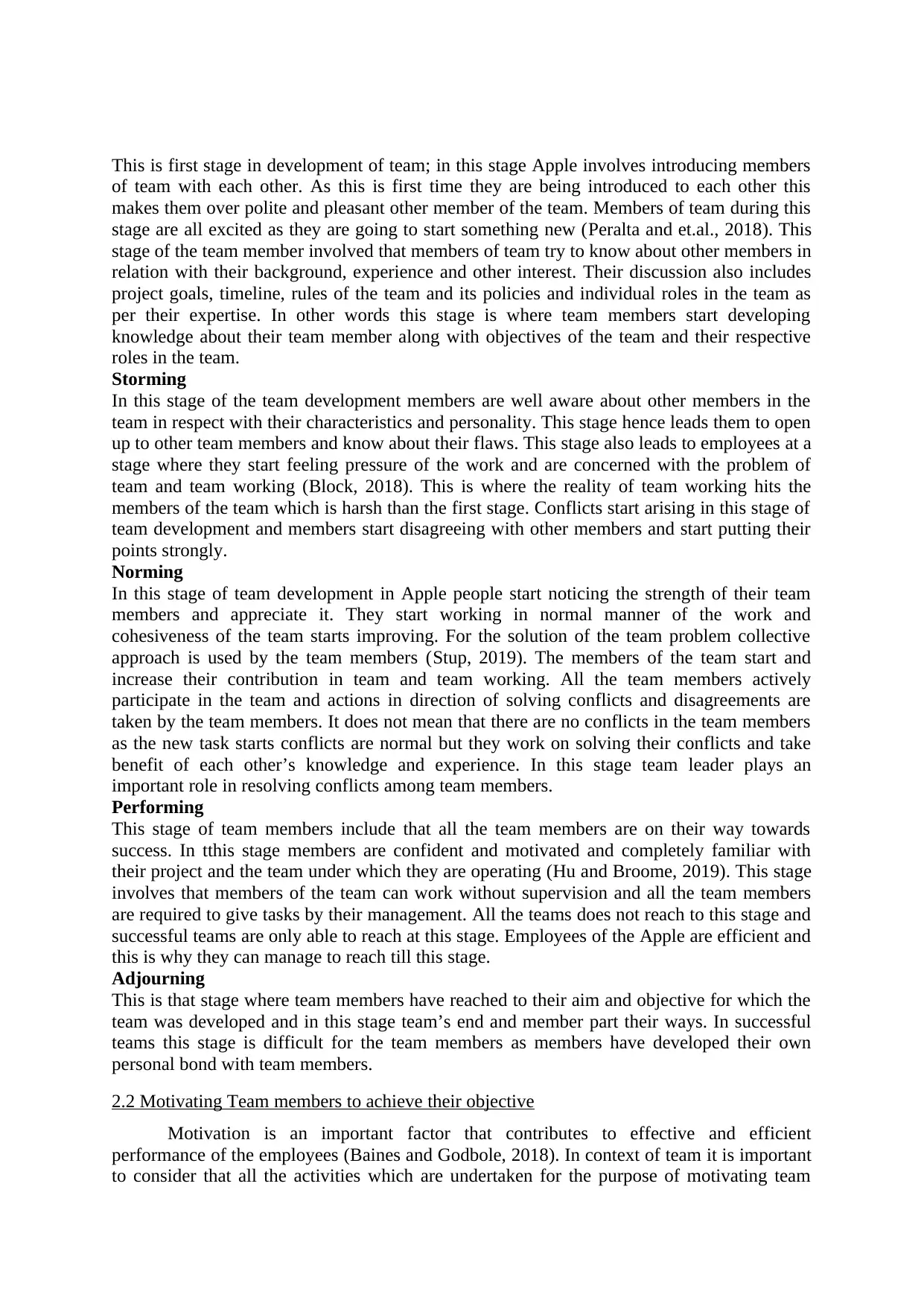
This is first stage in development of team; in this stage Apple involves introducing members
of team with each other. As this is first time they are being introduced to each other this
makes them over polite and pleasant other member of the team. Members of team during this
stage are all excited as they are going to start something new (Peralta and et.al., 2018). This
stage of the team member involved that members of team try to know about other members in
relation with their background, experience and other interest. Their discussion also includes
project goals, timeline, rules of the team and its policies and individual roles in the team as
per their expertise. In other words this stage is where team members start developing
knowledge about their team member along with objectives of the team and their respective
roles in the team.
Storming
In this stage of the team development members are well aware about other members in the
team in respect with their characteristics and personality. This stage hence leads them to open
up to other team members and know about their flaws. This stage also leads to employees at a
stage where they start feeling pressure of the work and are concerned with the problem of
team and team working (Block, 2018). This is where the reality of team working hits the
members of the team which is harsh than the first stage. Conflicts start arising in this stage of
team development and members start disagreeing with other members and start putting their
points strongly.
Norming
In this stage of team development in Apple people start noticing the strength of their team
members and appreciate it. They start working in normal manner of the work and
cohesiveness of the team starts improving. For the solution of the team problem collective
approach is used by the team members (Stup, 2019). The members of the team start and
increase their contribution in team and team working. All the team members actively
participate in the team and actions in direction of solving conflicts and disagreements are
taken by the team members. It does not mean that there are no conflicts in the team members
as the new task starts conflicts are normal but they work on solving their conflicts and take
benefit of each other’s knowledge and experience. In this stage team leader plays an
important role in resolving conflicts among team members.
Performing
This stage of team members include that all the team members are on their way towards
success. In tthis stage members are confident and motivated and completely familiar with
their project and the team under which they are operating (Hu and Broome, 2019). This stage
involves that members of the team can work without supervision and all the team members
are required to give tasks by their management. All the teams does not reach to this stage and
successful teams are only able to reach at this stage. Employees of the Apple are efficient and
this is why they can manage to reach till this stage.
Adjourning
This is that stage where team members have reached to their aim and objective for which the
team was developed and in this stage team’s end and member part their ways. In successful
teams this stage is difficult for the team members as members have developed their own
personal bond with team members.
2.2 Motivating Team members to achieve their objective
Motivation is an important factor that contributes to effective and efficient
performance of the employees (Baines and Godbole, 2018). In context of team it is important
to consider that all the activities which are undertaken for the purpose of motivating team
of team with each other. As this is first time they are being introduced to each other this
makes them over polite and pleasant other member of the team. Members of team during this
stage are all excited as they are going to start something new (Peralta and et.al., 2018). This
stage of the team member involved that members of team try to know about other members in
relation with their background, experience and other interest. Their discussion also includes
project goals, timeline, rules of the team and its policies and individual roles in the team as
per their expertise. In other words this stage is where team members start developing
knowledge about their team member along with objectives of the team and their respective
roles in the team.
Storming
In this stage of the team development members are well aware about other members in the
team in respect with their characteristics and personality. This stage hence leads them to open
up to other team members and know about their flaws. This stage also leads to employees at a
stage where they start feeling pressure of the work and are concerned with the problem of
team and team working (Block, 2018). This is where the reality of team working hits the
members of the team which is harsh than the first stage. Conflicts start arising in this stage of
team development and members start disagreeing with other members and start putting their
points strongly.
Norming
In this stage of team development in Apple people start noticing the strength of their team
members and appreciate it. They start working in normal manner of the work and
cohesiveness of the team starts improving. For the solution of the team problem collective
approach is used by the team members (Stup, 2019). The members of the team start and
increase their contribution in team and team working. All the team members actively
participate in the team and actions in direction of solving conflicts and disagreements are
taken by the team members. It does not mean that there are no conflicts in the team members
as the new task starts conflicts are normal but they work on solving their conflicts and take
benefit of each other’s knowledge and experience. In this stage team leader plays an
important role in resolving conflicts among team members.
Performing
This stage of team members include that all the team members are on their way towards
success. In tthis stage members are confident and motivated and completely familiar with
their project and the team under which they are operating (Hu and Broome, 2019). This stage
involves that members of the team can work without supervision and all the team members
are required to give tasks by their management. All the teams does not reach to this stage and
successful teams are only able to reach at this stage. Employees of the Apple are efficient and
this is why they can manage to reach till this stage.
Adjourning
This is that stage where team members have reached to their aim and objective for which the
team was developed and in this stage team’s end and member part their ways. In successful
teams this stage is difficult for the team members as members have developed their own
personal bond with team members.
2.2 Motivating Team members to achieve their objective
Motivation is an important factor that contributes to effective and efficient
performance of the employees (Baines and Godbole, 2018). In context of team it is important
to consider that all the activities which are undertaken for the purpose of motivating team
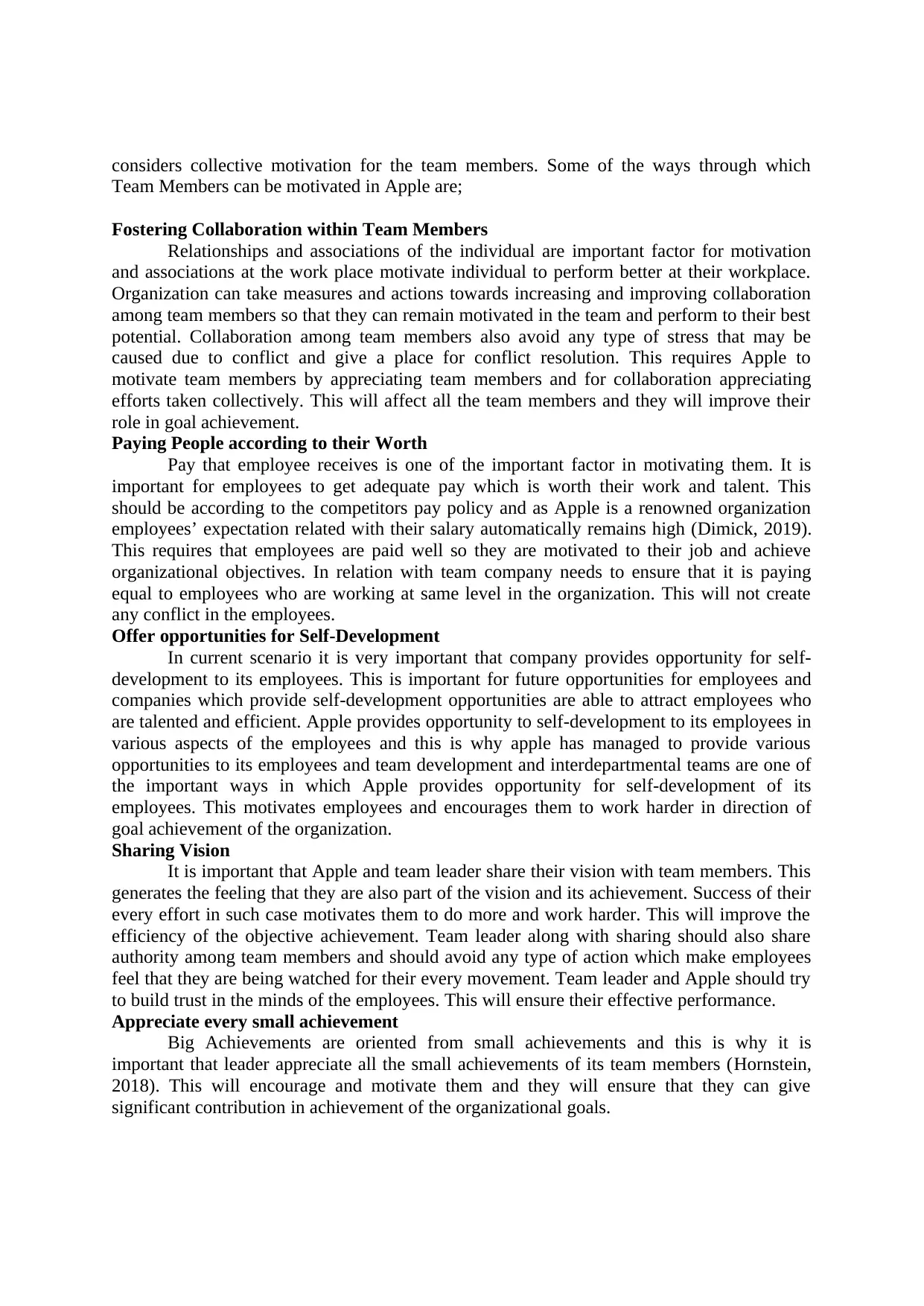
considers collective motivation for the team members. Some of the ways through which
Team Members can be motivated in Apple are;
Fostering Collaboration within Team Members
Relationships and associations of the individual are important factor for motivation
and associations at the work place motivate individual to perform better at their workplace.
Organization can take measures and actions towards increasing and improving collaboration
among team members so that they can remain motivated in the team and perform to their best
potential. Collaboration among team members also avoid any type of stress that may be
caused due to conflict and give a place for conflict resolution. This requires Apple to
motivate team members by appreciating team members and for collaboration appreciating
efforts taken collectively. This will affect all the team members and they will improve their
role in goal achievement.
Paying People according to their Worth
Pay that employee receives is one of the important factor in motivating them. It is
important for employees to get adequate pay which is worth their work and talent. This
should be according to the competitors pay policy and as Apple is a renowned organization
employees’ expectation related with their salary automatically remains high (Dimick, 2019).
This requires that employees are paid well so they are motivated to their job and achieve
organizational objectives. In relation with team company needs to ensure that it is paying
equal to employees who are working at same level in the organization. This will not create
any conflict in the employees.
Offer opportunities for Self-Development
In current scenario it is very important that company provides opportunity for self-
development to its employees. This is important for future opportunities for employees and
companies which provide self-development opportunities are able to attract employees who
are talented and efficient. Apple provides opportunity to self-development to its employees in
various aspects of the employees and this is why apple has managed to provide various
opportunities to its employees and team development and interdepartmental teams are one of
the important ways in which Apple provides opportunity for self-development of its
employees. This motivates employees and encourages them to work harder in direction of
goal achievement of the organization.
Sharing Vision
It is important that Apple and team leader share their vision with team members. This
generates the feeling that they are also part of the vision and its achievement. Success of their
every effort in such case motivates them to do more and work harder. This will improve the
efficiency of the objective achievement. Team leader along with sharing should also share
authority among team members and should avoid any type of action which make employees
feel that they are being watched for their every movement. Team leader and Apple should try
to build trust in the minds of the employees. This will ensure their effective performance.
Appreciate every small achievement
Big Achievements are oriented from small achievements and this is why it is
important that leader appreciate all the small achievements of its team members (Hornstein,
2018). This will encourage and motivate them and they will ensure that they can give
significant contribution in achievement of the organizational goals.
Team Members can be motivated in Apple are;
Fostering Collaboration within Team Members
Relationships and associations of the individual are important factor for motivation
and associations at the work place motivate individual to perform better at their workplace.
Organization can take measures and actions towards increasing and improving collaboration
among team members so that they can remain motivated in the team and perform to their best
potential. Collaboration among team members also avoid any type of stress that may be
caused due to conflict and give a place for conflict resolution. This requires Apple to
motivate team members by appreciating team members and for collaboration appreciating
efforts taken collectively. This will affect all the team members and they will improve their
role in goal achievement.
Paying People according to their Worth
Pay that employee receives is one of the important factor in motivating them. It is
important for employees to get adequate pay which is worth their work and talent. This
should be according to the competitors pay policy and as Apple is a renowned organization
employees’ expectation related with their salary automatically remains high (Dimick, 2019).
This requires that employees are paid well so they are motivated to their job and achieve
organizational objectives. In relation with team company needs to ensure that it is paying
equal to employees who are working at same level in the organization. This will not create
any conflict in the employees.
Offer opportunities for Self-Development
In current scenario it is very important that company provides opportunity for self-
development to its employees. This is important for future opportunities for employees and
companies which provide self-development opportunities are able to attract employees who
are talented and efficient. Apple provides opportunity to self-development to its employees in
various aspects of the employees and this is why apple has managed to provide various
opportunities to its employees and team development and interdepartmental teams are one of
the important ways in which Apple provides opportunity for self-development of its
employees. This motivates employees and encourages them to work harder in direction of
goal achievement of the organization.
Sharing Vision
It is important that Apple and team leader share their vision with team members. This
generates the feeling that they are also part of the vision and its achievement. Success of their
every effort in such case motivates them to do more and work harder. This will improve the
efficiency of the objective achievement. Team leader along with sharing should also share
authority among team members and should avoid any type of action which make employees
feel that they are being watched for their every movement. Team leader and Apple should try
to build trust in the minds of the employees. This will ensure their effective performance.
Appreciate every small achievement
Big Achievements are oriented from small achievements and this is why it is
important that leader appreciate all the small achievements of its team members (Hornstein,
2018). This will encourage and motivate them and they will ensure that they can give
significant contribution in achievement of the organizational goals.
⊘ This is a preview!⊘
Do you want full access?
Subscribe today to unlock all pages.

Trusted by 1+ million students worldwide
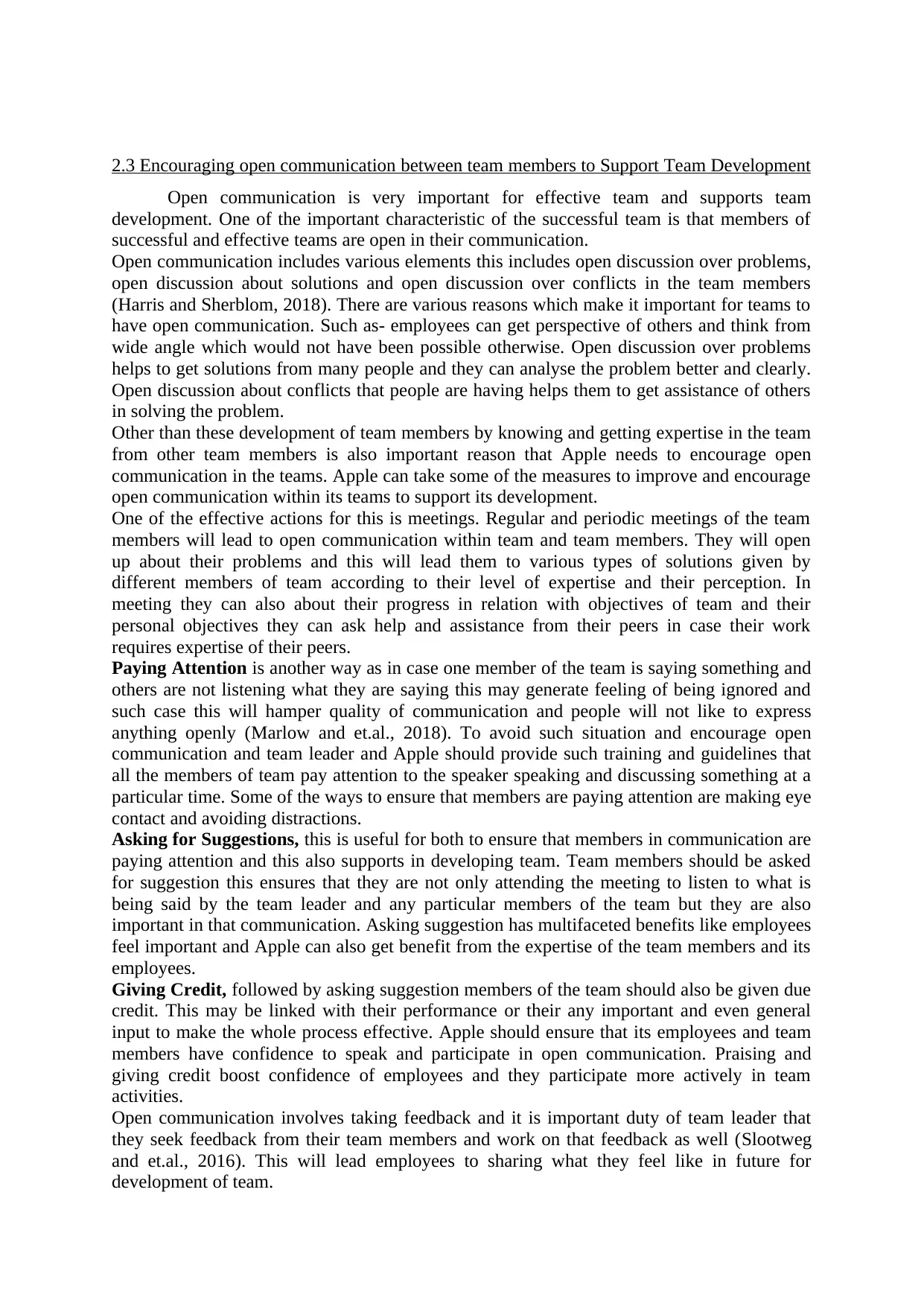
2.3 Encouraging open communication between team members to Support Team Development
Open communication is very important for effective team and supports team
development. One of the important characteristic of the successful team is that members of
successful and effective teams are open in their communication.
Open communication includes various elements this includes open discussion over problems,
open discussion about solutions and open discussion over conflicts in the team members
(Harris and Sherblom, 2018). There are various reasons which make it important for teams to
have open communication. Such as- employees can get perspective of others and think from
wide angle which would not have been possible otherwise. Open discussion over problems
helps to get solutions from many people and they can analyse the problem better and clearly.
Open discussion about conflicts that people are having helps them to get assistance of others
in solving the problem.
Other than these development of team members by knowing and getting expertise in the team
from other team members is also important reason that Apple needs to encourage open
communication in the teams. Apple can take some of the measures to improve and encourage
open communication within its teams to support its development.
One of the effective actions for this is meetings. Regular and periodic meetings of the team
members will lead to open communication within team and team members. They will open
up about their problems and this will lead them to various types of solutions given by
different members of team according to their level of expertise and their perception. In
meeting they can also about their progress in relation with objectives of team and their
personal objectives they can ask help and assistance from their peers in case their work
requires expertise of their peers.
Paying Attention is another way as in case one member of the team is saying something and
others are not listening what they are saying this may generate feeling of being ignored and
such case this will hamper quality of communication and people will not like to express
anything openly (Marlow and et.al., 2018). To avoid such situation and encourage open
communication and team leader and Apple should provide such training and guidelines that
all the members of team pay attention to the speaker speaking and discussing something at a
particular time. Some of the ways to ensure that members are paying attention are making eye
contact and avoiding distractions.
Asking for Suggestions, this is useful for both to ensure that members in communication are
paying attention and this also supports in developing team. Team members should be asked
for suggestion this ensures that they are not only attending the meeting to listen to what is
being said by the team leader and any particular members of the team but they are also
important in that communication. Asking suggestion has multifaceted benefits like employees
feel important and Apple can also get benefit from the expertise of the team members and its
employees.
Giving Credit, followed by asking suggestion members of the team should also be given due
credit. This may be linked with their performance or their any important and even general
input to make the whole process effective. Apple should ensure that its employees and team
members have confidence to speak and participate in open communication. Praising and
giving credit boost confidence of employees and they participate more actively in team
activities.
Open communication involves taking feedback and it is important duty of team leader that
they seek feedback from their team members and work on that feedback as well (Slootweg
and et.al., 2016). This will lead employees to sharing what they feel like in future for
development of team.
Open communication is very important for effective team and supports team
development. One of the important characteristic of the successful team is that members of
successful and effective teams are open in their communication.
Open communication includes various elements this includes open discussion over problems,
open discussion about solutions and open discussion over conflicts in the team members
(Harris and Sherblom, 2018). There are various reasons which make it important for teams to
have open communication. Such as- employees can get perspective of others and think from
wide angle which would not have been possible otherwise. Open discussion over problems
helps to get solutions from many people and they can analyse the problem better and clearly.
Open discussion about conflicts that people are having helps them to get assistance of others
in solving the problem.
Other than these development of team members by knowing and getting expertise in the team
from other team members is also important reason that Apple needs to encourage open
communication in the teams. Apple can take some of the measures to improve and encourage
open communication within its teams to support its development.
One of the effective actions for this is meetings. Regular and periodic meetings of the team
members will lead to open communication within team and team members. They will open
up about their problems and this will lead them to various types of solutions given by
different members of team according to their level of expertise and their perception. In
meeting they can also about their progress in relation with objectives of team and their
personal objectives they can ask help and assistance from their peers in case their work
requires expertise of their peers.
Paying Attention is another way as in case one member of the team is saying something and
others are not listening what they are saying this may generate feeling of being ignored and
such case this will hamper quality of communication and people will not like to express
anything openly (Marlow and et.al., 2018). To avoid such situation and encourage open
communication and team leader and Apple should provide such training and guidelines that
all the members of team pay attention to the speaker speaking and discussing something at a
particular time. Some of the ways to ensure that members are paying attention are making eye
contact and avoiding distractions.
Asking for Suggestions, this is useful for both to ensure that members in communication are
paying attention and this also supports in developing team. Team members should be asked
for suggestion this ensures that they are not only attending the meeting to listen to what is
being said by the team leader and any particular members of the team but they are also
important in that communication. Asking suggestion has multifaceted benefits like employees
feel important and Apple can also get benefit from the expertise of the team members and its
employees.
Giving Credit, followed by asking suggestion members of the team should also be given due
credit. This may be linked with their performance or their any important and even general
input to make the whole process effective. Apple should ensure that its employees and team
members have confidence to speak and participate in open communication. Praising and
giving credit boost confidence of employees and they participate more actively in team
activities.
Open communication involves taking feedback and it is important duty of team leader that
they seek feedback from their team members and work on that feedback as well (Slootweg
and et.al., 2016). This will lead employees to sharing what they feel like in future for
development of team.
Paraphrase This Document
Need a fresh take? Get an instant paraphrase of this document with our AI Paraphraser
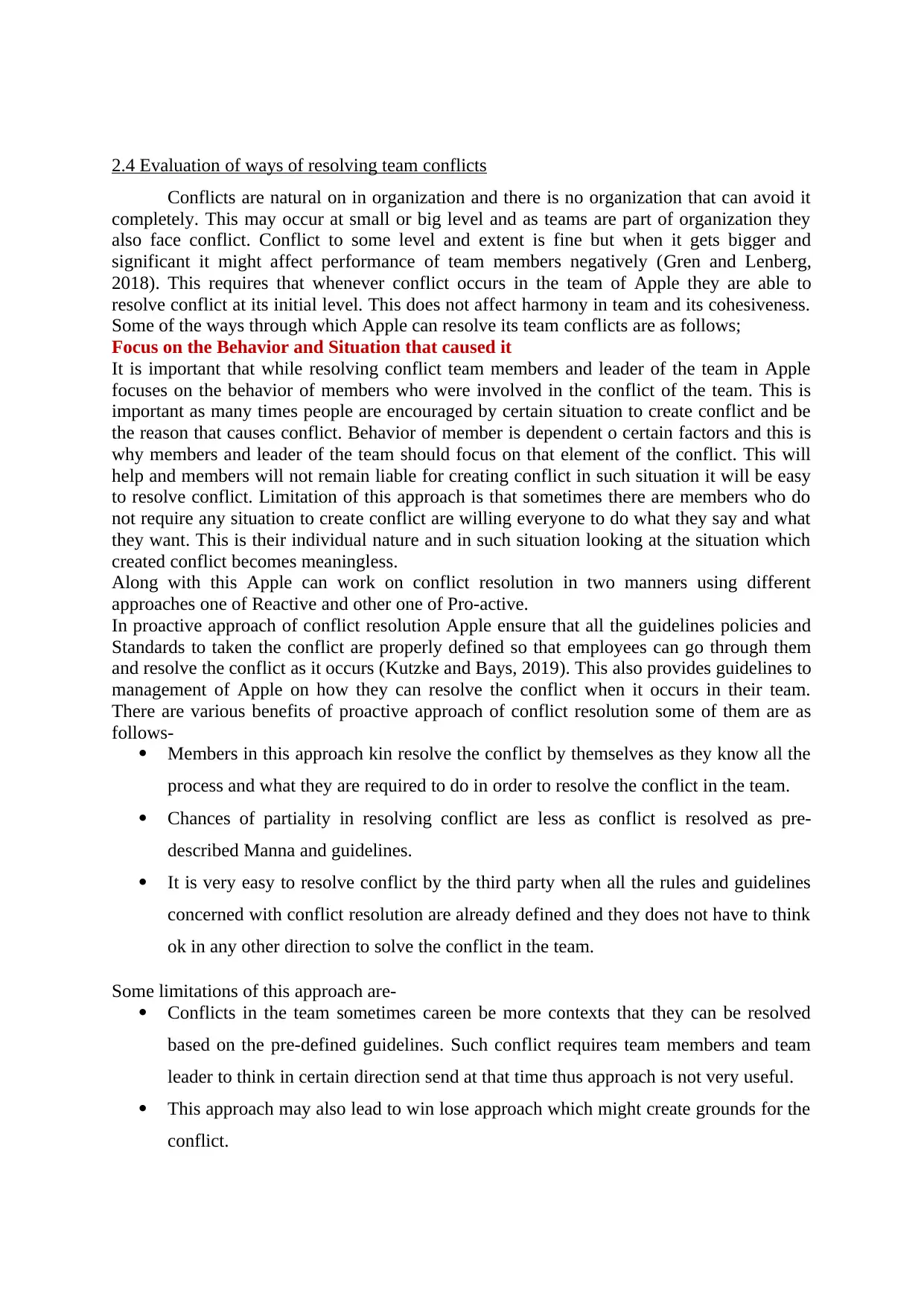
2.4 Evaluation of ways of resolving team conflicts
Conflicts are natural on in organization and there is no organization that can avoid it
completely. This may occur at small or big level and as teams are part of organization they
also face conflict. Conflict to some level and extent is fine but when it gets bigger and
significant it might affect performance of team members negatively (Gren and Lenberg,
2018). This requires that whenever conflict occurs in the team of Apple they are able to
resolve conflict at its initial level. This does not affect harmony in team and its cohesiveness.
Some of the ways through which Apple can resolve its team conflicts are as follows;
Focus on the Behavior and Situation that caused it
It is important that while resolving conflict team members and leader of the team in Apple
focuses on the behavior of members who were involved in the conflict of the team. This is
important as many times people are encouraged by certain situation to create conflict and be
the reason that causes conflict. Behavior of member is dependent o certain factors and this is
why members and leader of the team should focus on that element of the conflict. This will
help and members will not remain liable for creating conflict in such situation it will be easy
to resolve conflict. Limitation of this approach is that sometimes there are members who do
not require any situation to create conflict are willing everyone to do what they say and what
they want. This is their individual nature and in such situation looking at the situation which
created conflict becomes meaningless.
Along with this Apple can work on conflict resolution in two manners using different
approaches one of Reactive and other one of Pro-active.
In proactive approach of conflict resolution Apple ensure that all the guidelines policies and
Standards to taken the conflict are properly defined so that employees can go through them
and resolve the conflict as it occurs (Kutzke and Bays, 2019). This also provides guidelines to
management of Apple on how they can resolve the conflict when it occurs in their team.
There are various benefits of proactive approach of conflict resolution some of them are as
follows-
Members in this approach kin resolve the conflict by themselves as they know all the
process and what they are required to do in order to resolve the conflict in the team.
Chances of partiality in resolving conflict are less as conflict is resolved as pre-
described Manna and guidelines.
It is very easy to resolve conflict by the third party when all the rules and guidelines
concerned with conflict resolution are already defined and they does not have to think
ok in any other direction to solve the conflict in the team.
Some limitations of this approach are-
Conflicts in the team sometimes careen be more contexts that they can be resolved
based on the pre-defined guidelines. Such conflict requires team members and team
leader to think in certain direction send at that time thus approach is not very useful.
This approach may also lead to win lose approach which might create grounds for the
conflict.
Conflicts are natural on in organization and there is no organization that can avoid it
completely. This may occur at small or big level and as teams are part of organization they
also face conflict. Conflict to some level and extent is fine but when it gets bigger and
significant it might affect performance of team members negatively (Gren and Lenberg,
2018). This requires that whenever conflict occurs in the team of Apple they are able to
resolve conflict at its initial level. This does not affect harmony in team and its cohesiveness.
Some of the ways through which Apple can resolve its team conflicts are as follows;
Focus on the Behavior and Situation that caused it
It is important that while resolving conflict team members and leader of the team in Apple
focuses on the behavior of members who were involved in the conflict of the team. This is
important as many times people are encouraged by certain situation to create conflict and be
the reason that causes conflict. Behavior of member is dependent o certain factors and this is
why members and leader of the team should focus on that element of the conflict. This will
help and members will not remain liable for creating conflict in such situation it will be easy
to resolve conflict. Limitation of this approach is that sometimes there are members who do
not require any situation to create conflict are willing everyone to do what they say and what
they want. This is their individual nature and in such situation looking at the situation which
created conflict becomes meaningless.
Along with this Apple can work on conflict resolution in two manners using different
approaches one of Reactive and other one of Pro-active.
In proactive approach of conflict resolution Apple ensure that all the guidelines policies and
Standards to taken the conflict are properly defined so that employees can go through them
and resolve the conflict as it occurs (Kutzke and Bays, 2019). This also provides guidelines to
management of Apple on how they can resolve the conflict when it occurs in their team.
There are various benefits of proactive approach of conflict resolution some of them are as
follows-
Members in this approach kin resolve the conflict by themselves as they know all the
process and what they are required to do in order to resolve the conflict in the team.
Chances of partiality in resolving conflict are less as conflict is resolved as pre-
described Manna and guidelines.
It is very easy to resolve conflict by the third party when all the rules and guidelines
concerned with conflict resolution are already defined and they does not have to think
ok in any other direction to solve the conflict in the team.
Some limitations of this approach are-
Conflicts in the team sometimes careen be more contexts that they can be resolved
based on the pre-defined guidelines. Such conflict requires team members and team
leader to think in certain direction send at that time thus approach is not very useful.
This approach may also lead to win lose approach which might create grounds for the
conflict.
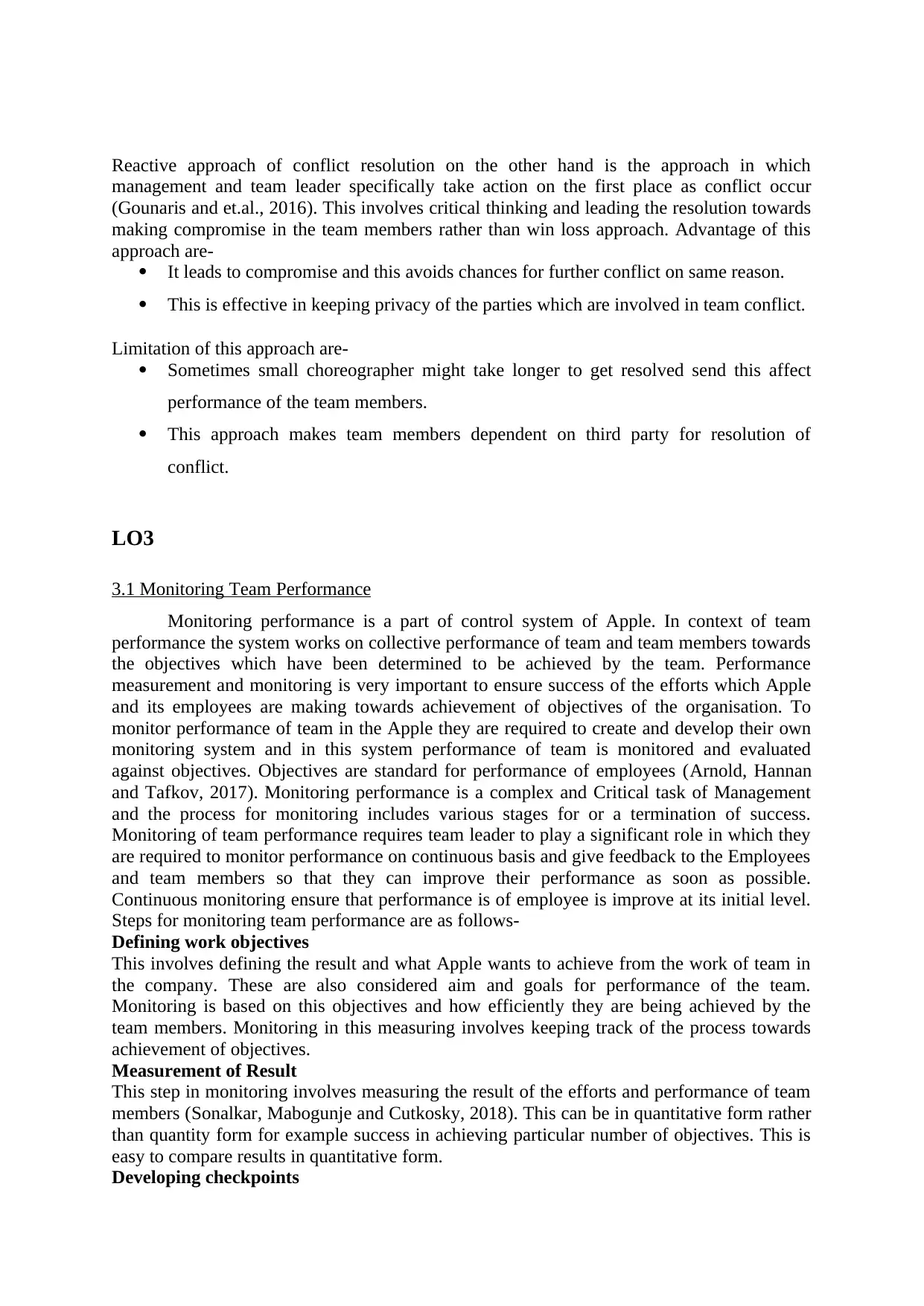
Reactive approach of conflict resolution on the other hand is the approach in which
management and team leader specifically take action on the first place as conflict occur
(Gounaris and et.al., 2016). This involves critical thinking and leading the resolution towards
making compromise in the team members rather than win loss approach. Advantage of this
approach are-
It leads to compromise and this avoids chances for further conflict on same reason.
This is effective in keeping privacy of the parties which are involved in team conflict.
Limitation of this approach are-
Sometimes small choreographer might take longer to get resolved send this affect
performance of the team members.
This approach makes team members dependent on third party for resolution of
conflict.
LO3
3.1 Monitoring Team Performance
Monitoring performance is a part of control system of Apple. In context of team
performance the system works on collective performance of team and team members towards
the objectives which have been determined to be achieved by the team. Performance
measurement and monitoring is very important to ensure success of the efforts which Apple
and its employees are making towards achievement of objectives of the organisation. To
monitor performance of team in the Apple they are required to create and develop their own
monitoring system and in this system performance of team is monitored and evaluated
against objectives. Objectives are standard for performance of employees (Arnold, Hannan
and Tafkov, 2017). Monitoring performance is a complex and Critical task of Management
and the process for monitoring includes various stages for or a termination of success.
Monitoring of team performance requires team leader to play a significant role in which they
are required to monitor performance on continuous basis and give feedback to the Employees
and team members so that they can improve their performance as soon as possible.
Continuous monitoring ensure that performance is of employee is improve at its initial level.
Steps for monitoring team performance are as follows-
Defining work objectives
This involves defining the result and what Apple wants to achieve from the work of team in
the company. These are also considered aim and goals for performance of the team.
Monitoring is based on this objectives and how efficiently they are being achieved by the
team members. Monitoring in this measuring involves keeping track of the process towards
achievement of objectives.
Measurement of Result
This step in monitoring involves measuring the result of the efforts and performance of team
members (Sonalkar, Mabogunje and Cutkosky, 2018). This can be in quantitative form rather
than quantity form for example success in achieving particular number of objectives. This is
easy to compare results in quantitative form.
Developing checkpoints
management and team leader specifically take action on the first place as conflict occur
(Gounaris and et.al., 2016). This involves critical thinking and leading the resolution towards
making compromise in the team members rather than win loss approach. Advantage of this
approach are-
It leads to compromise and this avoids chances for further conflict on same reason.
This is effective in keeping privacy of the parties which are involved in team conflict.
Limitation of this approach are-
Sometimes small choreographer might take longer to get resolved send this affect
performance of the team members.
This approach makes team members dependent on third party for resolution of
conflict.
LO3
3.1 Monitoring Team Performance
Monitoring performance is a part of control system of Apple. In context of team
performance the system works on collective performance of team and team members towards
the objectives which have been determined to be achieved by the team. Performance
measurement and monitoring is very important to ensure success of the efforts which Apple
and its employees are making towards achievement of objectives of the organisation. To
monitor performance of team in the Apple they are required to create and develop their own
monitoring system and in this system performance of team is monitored and evaluated
against objectives. Objectives are standard for performance of employees (Arnold, Hannan
and Tafkov, 2017). Monitoring performance is a complex and Critical task of Management
and the process for monitoring includes various stages for or a termination of success.
Monitoring of team performance requires team leader to play a significant role in which they
are required to monitor performance on continuous basis and give feedback to the Employees
and team members so that they can improve their performance as soon as possible.
Continuous monitoring ensure that performance is of employee is improve at its initial level.
Steps for monitoring team performance are as follows-
Defining work objectives
This involves defining the result and what Apple wants to achieve from the work of team in
the company. These are also considered aim and goals for performance of the team.
Monitoring is based on this objectives and how efficiently they are being achieved by the
team members. Monitoring in this measuring involves keeping track of the process towards
achievement of objectives.
Measurement of Result
This step in monitoring involves measuring the result of the efforts and performance of team
members (Sonalkar, Mabogunje and Cutkosky, 2018). This can be in quantitative form rather
than quantity form for example success in achieving particular number of objectives. This is
easy to compare results in quantitative form.
Developing checkpoints
⊘ This is a preview!⊘
Do you want full access?
Subscribe today to unlock all pages.

Trusted by 1+ million students worldwide
1 out of 16
Related Documents
Your All-in-One AI-Powered Toolkit for Academic Success.
+13062052269
info@desklib.com
Available 24*7 on WhatsApp / Email
![[object Object]](/_next/static/media/star-bottom.7253800d.svg)
Unlock your academic potential
Copyright © 2020–2025 A2Z Services. All Rights Reserved. Developed and managed by ZUCOL.





